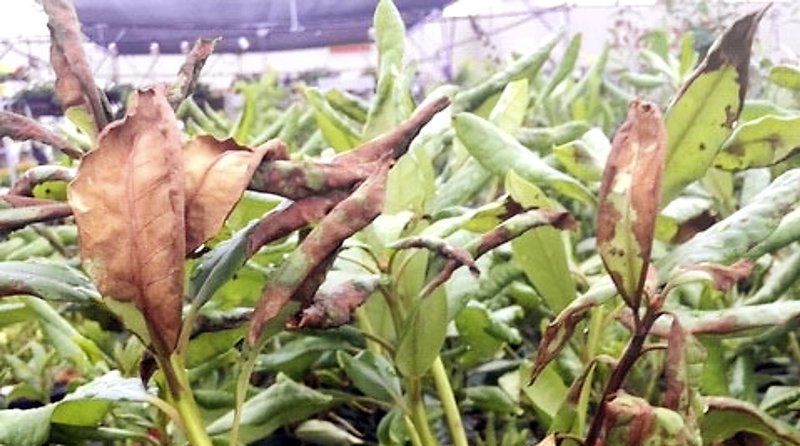
Indiana Department of Natural Resources
As you may remember, in June and July I blogged about a troubling outbreak of sudden oak death pathogen Phytophtora ramorum in the nursery trade. The discovery was made by Indiana authorities, who carefully inspected plants being sold in the state. They discovered that rhododendron plants imported from an Oklahoma wholesaler included infected plants.
By the end of May, Indiana state inspectors had destroyed more than 1,500 rhododendrons and prohibited sale of another 1,500 plants pending determination of their health. [source: Indianapolis Star 29 May, 2019] Over the next months, APHIS determined that more than 50 rhododendron plants found in Indiana nurseries had been infected [California Oak Mortality Task Force Newsletter August 2019 ].
In the spring and summer, APHIS and state authorities alerted 28 states that they might have received plants from the suspect sources – the suppliers of the Oklahoma wholesaler — one nursery in Washington State and two nurseries from Canada. In the end, APHIS determined that plants exposed to the pathogen had been sent to 18 states – Alabama, Arkansas, Iowa, Illinois, Indiana, Kansas, Kentucky, Michigan, Missouri, Nebraska, North Carolina, Ohio, Oklahoma, Pennsylvania, Tennessee, Texas, Virginia, and West Virginia. As of late July, P. ramorum-positive nursery stock had been detected in nurseries in seven of these (Iowa, Illinois. Indiana, Kansas, Missouri, Nebraska, Oklahoma) plus Washington [California Oak Mortality Task Force Newsletter August 2019].
As I pointed out in the earlier blog, this is just the latest of several occasions since 2004 in which infected plants have been widely distributed by the nursery trade, despite federal and state regulations. Also, at the time of this outbreak, APHIS had just formalized several steps relaxing the regulations that had been implemented through Federal Orders adopted in recent years. (See the earlier blog for details.)
APHIS actions
I wonder at APHIS’ delay in explaining to stakeholders the situation– and what it is doing about it! APHIS provided minimal information to me – by email rather than a public announcement; this email came a month after Indiana announced detection of the pathogen to the public (as reported in my blog). APHIS issued an official notice even later, in mid-July [California Oak Mortality Task Force (COMTF) Newsletter August 2019]. Neither notice was timely, given the serious risks to both nursery and naturally growing plants from the pathogen.
It is now November and principal questions have not yet been answered. How did the inspection systems in Washington and British Columbia fail to detect the outbreaks before the plants were shipped? This lapse is especially worrisome because APHIS requires testing of soil and standing water, not just visual inspection of plants. Furthermore, rhododendrons are well known to be vulnerable to the pathogen and therefore are a specified focus of detection efforts!
The October COMTF newsletter includes a report by the Washington State Department of Agriculture that a nursery found positive in May will carry out a Critical Control Points (CCP) assessment. An “extensive fall certification survey” will also be conducted. Presumably, these efforts are aimed at determining how the outbreak occurred.
The Canadian Food Inspection Service (CFIA) described – briefly – its nationwide survey program. CFIA reported that one nursery was determined to be P. ramorum-positive in 2018, three in 2019. CFIA says that trace-forwards and trace-backs demonstrate that no Canadian nursery shipped infected plants to the U.S. in 2018 or 2019. So, apparently, none of the infected plants came from the Canadian nurseries.
I hope that Washington State and APHIS will soon determine the probable causes of the outbreak. APHIS should then promptly inform all stakeholders and engage them in developing improved programs and policies to minimize the likelihood that similar problems will occur again.
Phytosanitary officials from the states are apparently also seeking additional information from APHIS about what went wrong and how the agency plans to fix the problems. See the resolution adopted by the National Plant Board here
California Action
A much more positive development is that the California Department of Food and Agriculture (CDFA) has introduced a Voluntary P. ramorum Pre-Quarantine Program. This is a voluntary inspection program specifically for nurseries in California counties that are not currently regulated for the pathogen – but that might be put under regulation in the future. Inspections and sampling will be administered by county regulatory officials and samples will be processed by the CDFA Plant Pest Diagnostics Center. If P. ramorum is detected at a participating nursery, the PQP nursery may become a federally regulated establishment.
Broader Implications
As I pointed out in Fading Forests III, APHIS and the states have struggled to prevent spread of tree-killing pests once they have established in the country. Even regulated pests – such as Phytophthora ramorum and the emerald ash borer — have escaped the regulations. APHIS and/or the states have chosen not to engage on other pests, such as redbay ambrosia beetle and laurel wilt disease and the polyphagous and Kuroshio shot hole borers and associated Fusarium fungus. In other cases, some states have acted – and asked APHIS to not get involved – e.g., thousand cankers disease of walnut. This situation heightens the risk to our urban, rural, and wildland forests. Americans need a hard-nosed discussion of how we can improve coordinated efforts to prevent pests’ spread.
Posted by Faith Campbell
We welcome comments that supplement or correct factual information, suggest new approaches, or promote thoughtful consideration. We post comments that disagree with us — but not those we judge to be not civil or inflammatory.


